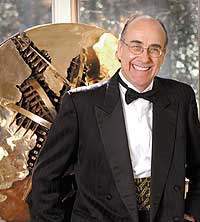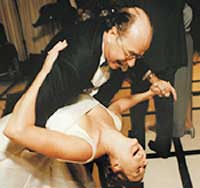Body and mind in motion: George O. Waring III
With talent and determination, George O. Waring III, MD, has challenged the ophthalmic standard, forging ahead with perpetual motion.
It is 8 o’clock on an icy January morning. George O. Waring, III, MD, has ascended in a helicopter to descend the deep back-country powder on the snowy slopes of a mountain peak in British Columbia. Amidst 5-foot drifts of snow he slows down, blocks the sun from his eyes and sizes up the next steep drop.
“I don’t take chances,” says the 61-year-old father of four, “I take risks.”
To Dr. Waring, taking chances is like playing Russian roulette. “Chance” means jumping into something before you know what your odds are. “Risks,” however, are calculated.
“To some degree, I calculate the consequences, I decide if I can afford the risks. And if I can, I go for it,” Dr. Waring said.
Dr. Waring has applied this philosophy to all aspects of his life, and it has served him well. His courage and talent have made him a respected international expert on corneal and refractive surgery, a recognized authority in the ophthalmic world.
An early start
Dr. Waring was born in Buffalo, N.Y., in 1941. In his youth, his family moved frequently. His parents never stayed in one place for more than 5 years.
During his childhood, a fascination for the inner workings of the body led him to reconstruct a dog skeleton and enter it in his eighth grade science fair. To his mother’s dismay, young George had brought home a dog that had been put to sleep at the local pound. He skinned and gutted it in a pit in the backyard. “I went down to the local library and got a book on bones. I rebuilt it myself with wires and glue,” Dr. Waring said.
He won second prize. “First prize was given to some nerd working on some unheard-of thing called DNA,” he joked.
After a liberal arts education at Wheaton College in Illinois, Dr. Waring studied medicine at Baylor Medical College in Houston, where he was influenced by a South African physician named Ben Cooper, a neurologist with an interest in neuro-ophthalmology. Under Dr. Cooper’s direction, Dr. Waring wrote a senior-year thesis on papilledema.
During this time Dr. Waring was interested in eye care but was unsure if he wanted to pursue it as a career. As a senior student in the eye clinic, he looked through a slit lamp.
“I was immediately struck by the beauty of the moving iris at that magnification. I was hooked,” he said.

An avid art collector, Dr. Waring stands in his home by a bronze (Disc After a Desert Rose), by Italian artist Renaldo Pomodoro, a piece accessed with the help of Dr. Waring’s Italian ophthalmic colleagues.
Images: Waring GO
Cornea subspecialty
Dr. Waring did his residency at Wills Eye Hospital in Philadelphia when Arthur Keeney, MD, was ophthalmologist in chief. In 1973 he began a fellowship at Wills with Peter Laibson, MD. He focused his energies on the refractive properties of the cornea and subsequently became a specialist in corneal and refractive surgery.
In Philadelphia, three of his children were born, George O. IV, John Timothy and Joy Ailene. His fourth child, Matthew George, was adopted in 1997.
After his residency he accepted a professorship in ophthalmology at the University of California-Davis.
During 5 years at UCD, Dr. Waring established the first eye bank of Northern California.
“Up to that point, there was no donor service available north of San Francisco or south of Portland,” he said.
With the help of two department chairmen at the university, Drs. Jerry Portney and John Keltner, Dr. Waring set up the Sacramento Valley Lions Eye Bank in 1975, which is still in operation.
His first National Eye Institute research grant was received there, to study lipid corneal dystrophy in dogs.
In 1979, Dr. Waring accepted a position at the Emory University School of Medicine.
“Up until that point, I had never lived in one place for more than 5 years,” Dr. Waring said. “I came to Emory, I liked it, and I stayed. We’ve been here for 22 years.”
The PERK study
In his early years at Emory, Dr. Waring became interested in radial keratotomy, a refractive procedure that was relatively new. At the time there was no formal scientific evidence on the efficiency and safety of RK.
“It became apparent to me that we would have to have a formal study,” Dr. Waring said. “So I put together a trial, recruited nine centers and worked on it for 15 years.”
Dr. Waring was a principal investigator in the study named the Prospective Evaluation of Radial Keratotomy (PERK). He credits fellow researchers Richard L. Lindstrom, MD, Marguerite B. McDonald, MD, and many others for their diligent work.
The PERK study was the first formal clinical study of refractive surgery. It garnered attention not only in medical circles but also in the media. Dr. Waring made appearances on television shows including “Today,” “Nightline” and “The McNeil-Lehrer NewsHour.”
It also drew litigious interest. A lawsuit was filed against Dr. Waring, participants in the PERK study and other ophthalmologists by surgeons claiming the study engaged in antitrust activity by restricting the trade of doctors who wanted to perform RK. Dr. Waring and his PERK colleagues held that RK outside the study should be done cautiously until reliable scientific evidence was documented.

Dr. Waring helped celebrate his daughter Joy’s wedding with a dance and dip with the bride.
“After months of deliberating, we won the jury trials and the appeals, and it set a case law which stated that scientific studies of medical procedures cannot be portrayed as a limiting, antitrust activity, because they are trying to generate reliable information,” Dr. Waring said.
Dr. Waring’s leadership role in the PERK study was a landmark in his life, he said.
“It truly was the single most important study that I have done in my professional life,” he said.
More than 30 peer-reviewed papers have been published based on data gathered in the PERK study. Dr. Waring has been active in publishing throughout his professional life, with articles, books and book chapters to his credit. He has also been the editor in chief of the Journal of Refractive Surgery, a SLACK Incorporated publication, for 13 years.
Early days of excimer
After RK was established as a viable modality for refractive surgery, in the mid-1980s excimer laser ablation of corneal tissue began to interest some pioneering refractive surgeons. Until that time, the excimer laser had primarily been used in the etching of computer microchips. Dr. Waring received a grant from the National Eye Institute to study the use of the excimer laser in monkeys. Dr. Waring performed this research at the Yerkes Regional Primate Research Center in Atlanta.
Following this early animal research, he worked as a principal investigator in clinical trials of photorefractive keratectomy with the Summit Technology excimer laser in human eyes. The data that he and others collected was presented before the Food and Drug Administration, and the device was approved in 1992.
“This was the first approval for the clinical use of the excimer laser by the FDA. It was a proud moment for me,” Dr. Waring said.
As surgeons began to perceive the limitations of PRK, the concept of LASIK was introduced to ophthalmology in the mid-1990s. Dr. Waring immediately became interested in its possibilities and was an early adopter of the procedure. But he became frustrated with FDA restrictions on the use of LASIK.
“During this time, it became clear to me that if I was going to be an expert in refractive surgery, I would have to get my LASIK learning abroad, because the FDA constraints were preventing me from progressing further,” he said.
Dr. Waring took a leave of absence from Emory University and moved to Jeddah, Saudi Arabia. There he worked at the El-Maghraby Eye Hospital and Medical Center, performing surgery with microkeratome and excimer laser without FDA strictures.
“We performed hundreds of surgeries. It was a wonderful experience that helped me build an excellent background in excimer refractive surgery,” Dr. Waring said.
Accomplishments near and far
Living and working abroad was not new to Dr. Waring. He had been a fellow research associate at the Hôtel Dieu in Paris in 1992, and he has lectured and taught internationally throughout his career, visiting 55 countries and giving more than 500 presentations on corneal and refractive surgery and ocular diseases in a number of subspecialties.
Despite the heavy travel schedule, in 1994 Dr. Waring helped to establish The Emory Clinic in Atlanta, in collaboration with Emory University.
“The clinic is unique in that it is in a partnership with Emory University,” Dr. Waring said. The clinic is staffed by Emory physicians and is one of the largest refractive surgery centers in the country. “We have done more than 30,000 refractive surgeries. We do all refractive procedures, Intacs corneal rings, thermal keratoplasty — and even RK when needed,” he said.
The center is currently involved in the development of wavefront technology for measuring the aberrations of the eye’s optical system and the application of this information to refractive surgical procedures, under the direction of Keith Thompson, MD.

Dr. Waring heads for the Monashee mountains in British Columbia annually for heliskiing. The helicopter drops Dr. Waring and his party, usually containing some of his ophthalmic colleagues, at the top of the mountain, and they descend engulfed in the deep powder.
Dr. Waring said wavefront technology will change the way ophthalmologists approach corneal refractive surgery in the future.
20/10 by 2010
Another technology that Dr. Waring predicts will have a significant impact on refractive surgery is the use of phakic IOLs.
“They are my major interest right now,” Dr. Waring said. He is the world medical monitor for Bausch & Lomb and is investigating their phakic IOL designs. He is also an investigator for Ophtec.
“I think once phakic IOLs are approved in the United States they will greatly impact refractive surgery,” he said.
Another of his current interests is microincision cataract surgery (MICS). MICS is performed using the Dodick YAG laser (ARC Laser Corp). It employs a corneal incision of 1 mm or less.
With the introduction of accommodating and phakic IOLs will come the blending of cataract and refractive surgery, Dr. Waring said.
“I believe the two fields overlap. They are basically two aspects of the same thing,” he said.
With the fusing of cataract and refractive surgery, Dr. Waring said he hopes to be able to give 90% of his patients 20/10 vision by the year 2010. He foresees LASIK procedures performed as an adjunct to cataract surgery or to the implantation of phakic IOLs. Combinations of procedures and technologies will lead to sharper postoperative vision, he said.
“We have 8 more years to perfect it. We’re working eagerly to reach the goal of 20/10 by 2010,” Dr. Waring said.
For Your Information:
- George O. Waring III, MD, can be reached at Emory Vision Correction Center, Emory University School of Medicine, 4170 Ashford Dunwoody Road, Suite 300, Atlanta, GA 30319; (404) 250-9700; fax: (404) 250-9006; e-mail: georgewaring@emoryvision.com.
